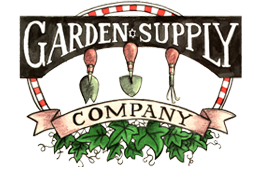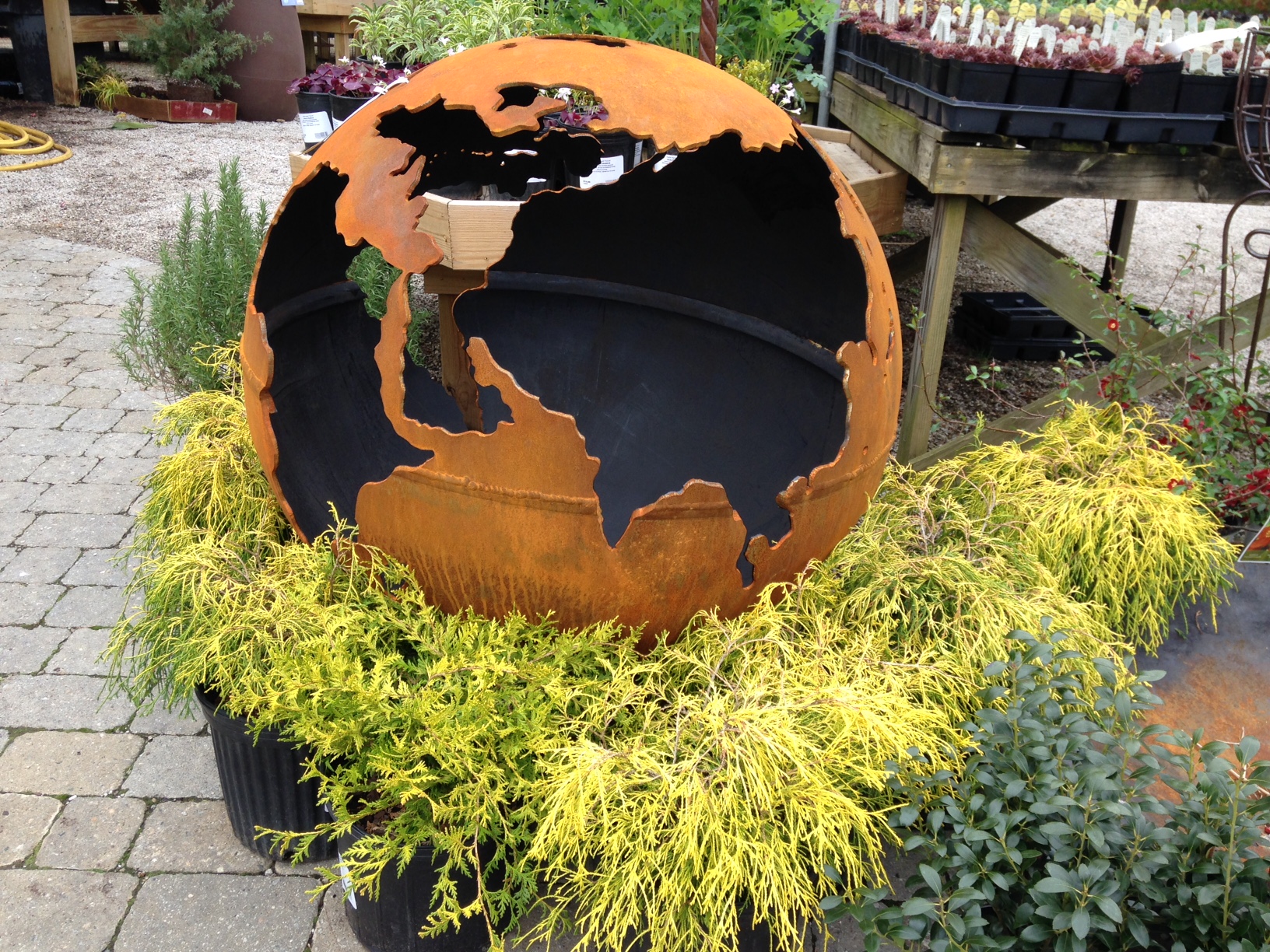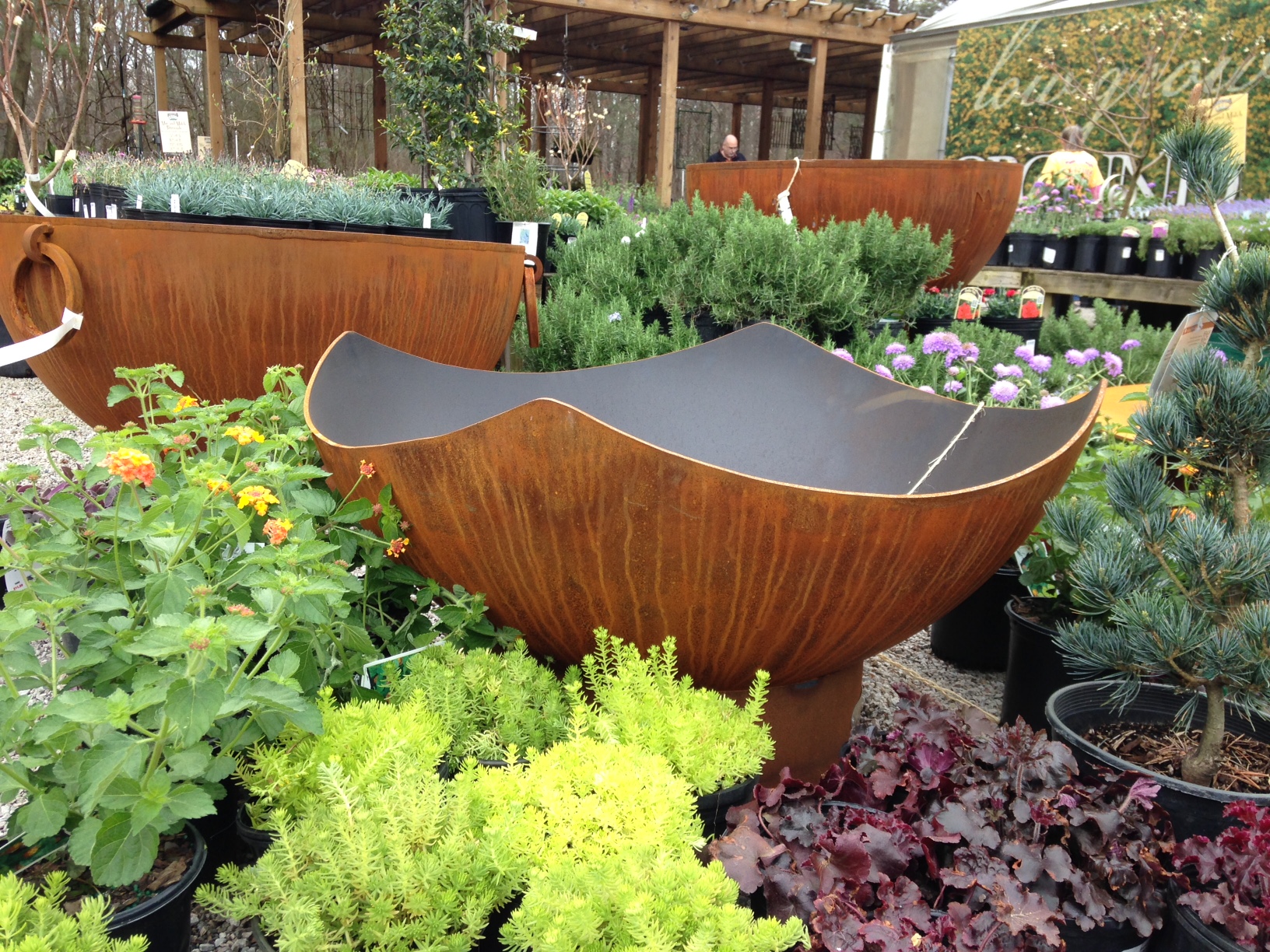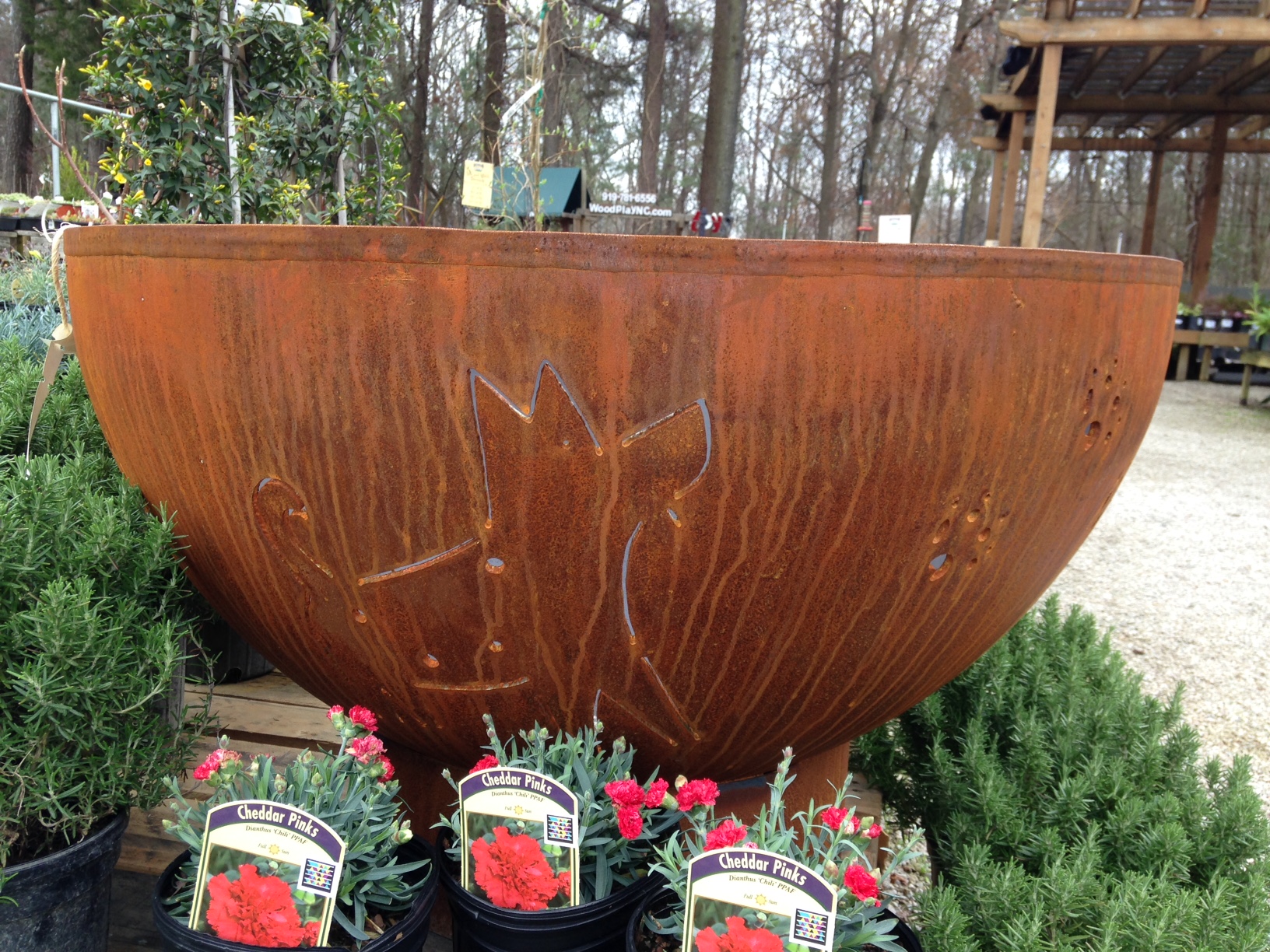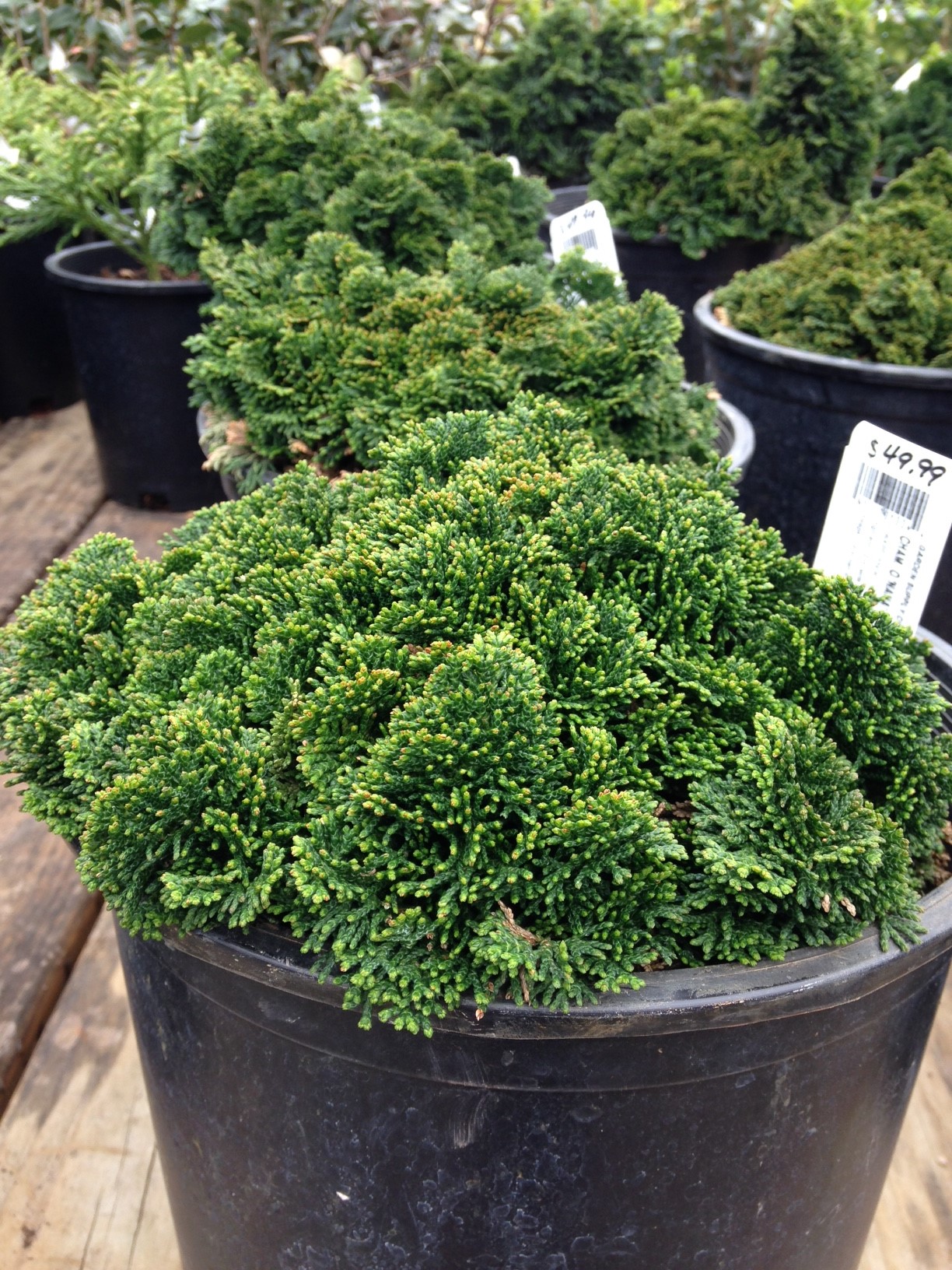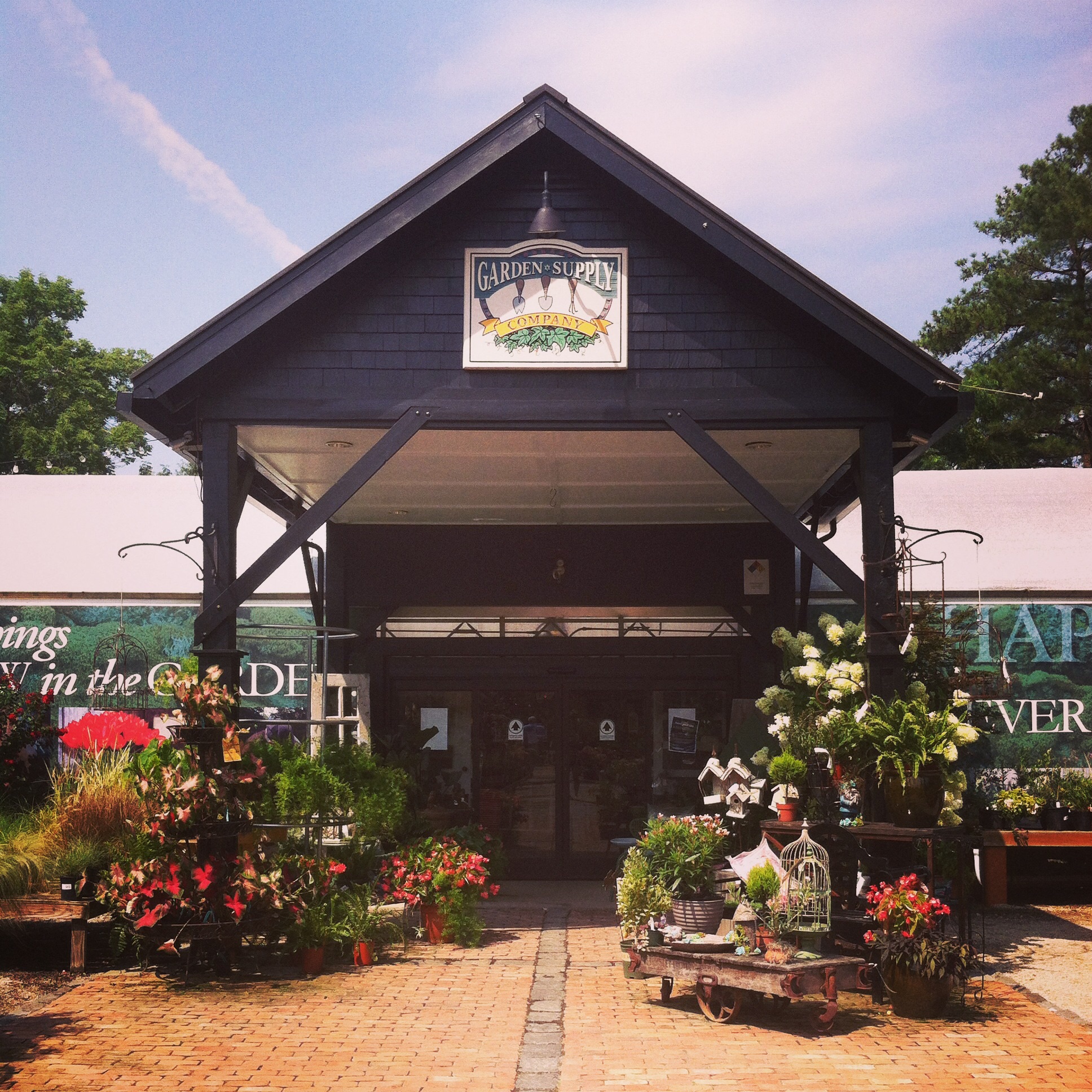We’ve previously put up a post on Fire Pit Fun where we talked about the many exciting benefits of fire pits. If you’re interested in fire pits, we have a selection right now from Rick Wittrig from FirePitArt.com. Rick lives and works out of Tennessee making beautiful functional steel art of high quality. If you’re thinking of getting a fire pit, check out the pieces we have because they make a statement, are built to last, and would be the perfect outdoor gathering spot for your friends and family!
Unusual Conifers Are Here!
Conifer trees have unique leaves or needles which are mostly evergreen. They are often fast-growing trees and can be large in size or small, depending on whether they are a dwarf variety. These trees need little pruning unless needed to keep them the right size for the space they are growing. Conifers can make a statement in your yard or have a utilitarian use as a hedge. They provide structure for yards and are important in winter months—not only do they provide green when most trees are bare, they also offer protection for birds from wind and precipitation. We have a selection of unusual conifers in right now which would be a distinctive addition to your yard:
Slenderina Blue Spruce
This tree grows up to 20 feet tall and can spread as much as 12 feet. It has a unique blueish color and grows in a graceful drooping pattern. It is slow growing with a low canopy, and can live for 80 years or more.
Weeping Blue Alaskan Cedar
This tree is an eye-catching addition to any landscape. It can grow up to 35 feet tall with a 5 foot spread and takes on a conical shape with branches that curve downwards.
Habari
This is an extremely dwarf selection that grows 36 inches tall and only a few inches wide. Foliage is compressed on irregular, stubby branches and evergreen.
Falsecypress
This evergreen plant is upright and narrow with twisted growth. It is a great screen plant for a narrow hedge and is deer resistant. This conifer grows to 4.5 feet tall and 2.5 feet wide and likes full sun.
Nana
This is a dwarf hinoki cypress is an extremely dwarf conifer, growing 8 inches high and 12 inches wide. The bright green mounding foliage creates interest in any season. It likes full to part sun.
Boulevard Topiary
Soft textured silvery-blue foliage on this specially pruned conifer give it a unique look. To keep its shape, pruning is needed.
Japanese White Pine
This is a hardy tree that thives outside in the sun and is very ornamental. It grows in an irregular but mostly conical shape that can get up to 25 feet tall and just as wide.
Golden Pillar
This conifer has beautiful bright golden-yellow foliage and is conical growing. It reaches 20 feet tall by 8 feet or more wide and full sun is needed for best color.
Redbuds and Cherry Trees: Harbingers of Spring
Redbuds and cherry trees are early bloomers in spring and we’re seeing them bud and bloom now, which can only mean one thing: spring is upon us!
Redbuds are relatively small, ornamental trees with short trunks and branches that spread out. This tree is well-regarded for its hardiness and adaptability. It blooms early with beautiful flowers that last for at least two to three weeks. Redbuds like moist soil and can tolerate full sun to shade.
Cherry trees are also early bloomers that make a striking showcase with their white-pink, fragrant flowers. Weeping cherry trees have slender branches that gracefully arc down to the ground. They grow in to a rounded shape and when covered with blooms, make the whole tree look like one blossom. Cherry trees prefer full sun and well-draining soil.
Both of these trees make perfect specimen plants and their early blooms will signal the start of spring to you year after year. We have a selection of redbuds and cherry trees which are blooming and this is the perfect time to plant them.
Stop by and one of our friendly associates will gladly help you get set up with one of these blooming trees in your garden.
Health Benefits of Honey
Honey
Honey
Honey is a unique substance: it’s a blend of vitamins, minerals, amino acids, trace enzymes, and sugar. It’s quite different from any other sweetener on the market. Just one pound of honey takes 60,000 bees visiting 2 million flowers across 55,000 miles, which is incredible. Honey flavor and color can vary depending on what kind of flower was visited to make it. Honey is a power-packed food with an assortment of health benefits. According to the National Institutes of Health, honey is “hygroscopic, antibacterial, and anti-inflammatory.” It does not go bad and has been used as a medicinal remedy for thousands of years. Eating local honey may relieve seasonal allergies. Experts say that exposure to small amounts of the allergens found in flower pollen may reduce symptoms. Honey is also said to be a natural cough soother. With its antibacterial and anti-inflammatory properties, honey can be used as a natural treatment for wounds and minor burns.
Here is an amazing Honey Dressing recipe from My Recipes:
1/3 cup white balsamic vinegar
2 tablespoons honey
1 tablespoon Dijion mustard
½ teaspoon salt
½ teaspoon black pepper
2/3 cup extra virgin olive oil
Mix together and enjoy!
We have our own honey and Bell's honey in stock, come in and try some!
Hardy Winter Perennials
Hardy Winter Perennials
As we truck along through the cold winter weather, we decided to discuss some perennials which thrive in the winter. We have created a special display out front that showcases an assortment of hardy winter perennials so if you’re looking for ideas, you may want to check that out. Here are a few plants to consider:
Euphorbia
There are a wide range of varieties that fall into the Euphorbia species—over 2,000 plants ranging from weeds to trees to succulents are encompassed in this group. We have a selection of evergreen Euphorbias in an array of colors.
We have Glacier Blue, which has wonderfully variegated leaves and conical flowers in the spring. There is also the Mini Martini variety, which is a dwarf hybrid, and on which new growth appears as a deep burgundy. Ascot Rainbow is another species of Euphorbia we have which is stunning at this time of year, with green and yellow variegated leaves with touches of red and orange on them.
These plants enjoy full sun to part shade and well-draining soil with moderate water levels. They can handle drought conditions well and overall, are fairly easy to care for. They will flower in the spring and are a great evergreen choice for this area. If you are looking for a way to give your garden a splash of color in the winter, these plants are perfect!
Heucheras
Heucheras
Heucheras are a shade-loving perennial plant that overwinters well in our climate. These plants have exploded in popularity in recent years and a lot of cultivars are on the market. They come in range of colors from black, burgundy, orange, and green, and with an variety of variegation and leaf shape. Some, like ‘Mocha’, turn from a dark brown/black color to a beautiful red/orange in the depths of winter, giving your garden a pop of color just when you need it most.
Heuchera like moist, well-draining soil in a spot that is protected from harsh afternoon sun. They like to be divided every three to four years and enjoy some fertilization on a regular basis. A bonus—they attract hummingbirds and butterflies when they bloom. They are a sturdy plant that can provide constant interest in your garden and thrive in those shady spots that can be tough to fill with color.
Seaside Chic is Here to Stay
This is not the first year that the "Nautical" theme has been popular, and it will not be the last. What makes this trend unique this year is the colors. Pantone Color Institute, a leading forecaster in the design industry, has debuted its Spring 2015 colors. Two of these colors are abundant in this seaside inspired theme. Lucite Green and Aquamarine add a perfect pop of color among traditional nautical neutrals like grey and beige. These colors have a calming effect so they are perfect for a relaxation space. Pairing these trendy colors with neutrals creates balance. We chose to use light, sandy beige and soft greys. These colors remind us of seashells and sand, two things you can't go without in a seaside theme.
Texture is an important element of this theme. Balance out the rough textures of rope with the smooth textures of sea glass. Use artificial (or real) botanical pieces to bring in leafy texture. In our theme, we used rope on our candle holders and jars, but it can be used in other ways too. Weave rope into a wreath to tie it into the theme, or pin it to the edges of a table or frame. Glass, both clear and colored, brings soft shine into the theme and can be reminiscent of portholes on a ship. Wreaths and other botanical pieces add a living element to this theme. After all, the ocean is full of life.
Rattan, burlap, and cork are other fun textures that you can bring into your theme because they are rough, but light enough that you will not feel weighed down. Balance and proportion are a fun way to add interest to your nautical theme. Use one or two large focal pieces to draw in the eye of your audience, then use smaller pieces of varying size to move their eyes along your space. Using odd numbers is always pleasing to the eye so add things is sets of three or five. We use this rule when adding artificial botanical stems.
Look around your home and see what things you already have that fit this theme, then work from there. You may be surprised what can fit into this theme. And as always, we hope you think of us next time you need that special decor or plant item for your home.
Don't forget to follow us on Facebook where we will be posting about new merchandise, sales, and classes all season long.
2015 is the Year of the…
Coleus
Every year, the National Garden Bureau selects one annual, perennial, and edible plant as their “Year of the” plants. They choose these based on how each plant’s popularity, easiness-to-grow, adaptability, genetic diversity, and versatility. This year they have selected: Annual of the Year: Coleus
Coleus is a sturdy plant that doesn’t need too much care from gardeners. These plants are available in a wide range of colors and varieties and make a stunning statement wherever you decide to put them.
Perennial of the Year:Gaillardia
This is a beautiful flowering plant is in the sunflower family and comes in shades of red, orange, yellow, brown and white. It has a long season of bloom and attracts butterflies.
Gaillardia
Edible of the Year:Sweet Pepper
Sweet peppers offer something for everyone—they come in a lot of different shapes, sizes, and colors. They are a garden favorite and are ideal for spot planting around your garden.
We’re still in the midst of winter but spring is just around the corner! As we approach warmer weather, consider finding a place for some of these plants in your garden. Come in to see us to learn what we have in stock and tips to make these plants thrive.
Growing Cacti and Succulents
Cacti and succulents are excellent houseplants that add character to any room. Firstly, understand that the words cactus and succulent are general terms that refer to a wide variety of plants. Anything called a “cactus” belongs to a certain family of plants but may be one of many different species. “Succulent” is not a family of plants, but refers to any plant with fleshy parts for storing moisture. A wide range of plants from many different parts of the world falls into the succulent category. Cacti are defined as succulents and what sets them apart as their own sub-group within that classification is that they produce growths (areoles) such as spines. These spines help defend the plant against being eaten, as well as helping to reduce water loss by diminishing the air flow close to the cacti stem and offering a little shade. What sets cacti and succulents apart is their ability to exist on low amounts of moisture. Both of these categories of plants are adept at conserving water and nutrients. Keeping indoor cacti or succulents require a special kind of care which is different from most other houseplants. These plants are tough and can stand extreme conditions with little water, but in order to thrive, they need regular care and attention. During their growth season (which is usually spring to fall), cacti and succulents will appreciate regular watering and fertilizing. Check out the tag on your individual plants to identify the specific needs of that species and ensure you successfully care for the plant. These plants do enjoy a lot of sunlight and whether they like direct or indirect light will depend on the variety, so make sure you have the right spot to meet its needs. You can always supplement light needs with a grow light if you don’t have enough daylight in your house. Cacti and succulents like a well-draining soil and should be repotted every year or two, as they outgrow their current pots and to give them fresh soil.
We have a selection of cacti and succulents, so stop in and check them out! They may be the perfect plants to supplement your indoor houseplant collection and our friendly staff will be glad to assist you in understanding their care!
Fun with Ferns
Ferns are a lacy, whimsical plant that add visual interest to any room. Their beautiful delicate appearance and easy needs make them an ideal choice to grow indoors. They gained popularity as indoor plants in the Victorian Era and the word “fern” comes from an Anglo-Saxon word (fearn) which means feather. These plants happen to be one of the only plants that do not produce flowers. They produce spores to reproduce. Ferns are native to the tropics and so enjoy high humidity, making them a good option for a bathroom. You can also mist them daily with a spray bottle, and if the humidity levels are not right, you may notice the tips of the fronds turning brown or dying. Another option to increase moisture levels around ferns is to double pot them. Place the potted fern in a larger container that is lined with moist sphagnum moss and be sure to keep the moss moist.
Depending on the type, ferns can have a variety of sunlight needs. Some like indirect sunlight, some will do fine with dappled or morning sun, and some can handle full sun. Check the tags on your chosen variety to ensure proper conditions. Their soil should stay evenly moist—not too wet and not too dry. When overwatered, their leaves will turn yellow and wilt. Water slowly and evenly until water runs out the bottom of the pot into the saucer. Ferns like light applications of houseplant fertilizer to stay happy and healthy.
Different ferns and plants
Ferns should be repotted every couple years. If your fern starts looking lackluster, rejuvenate it with some outdoor time in the warm months. Place the pot in a shady spot so it can experience the fresh air and rain.
We currently have an incredible selection of ferns so if you want to give this beautiful plant a try, come see us! Our friendly associates can get you set up with everything you need to make your indoor fern a success.
GSCO has Reopened!
GSCO Closed Today January 9th
Dress up your Houseplants!
Adding decorations and character to your houseplants pots can be fun and rewarding. We have a number of items that can be used to give your pots a unique look, check out some of the options we have: Moss: using moss in potted plants can give them a natural look. You can use moss across the top of plants to add a bit more interest than just the soil or mulch can provide. Using moss to decorate houseplants doesn’t have to mean simply laying it on the soil; there are also moss shapes available to draw attention.
Decorations: we have a variety of fun items to be used in pots, such as these colorful glass mushrooms. This type of item can add color and a feel of whimsy to any plant. We have other items as well, such as signs and other types of decorative objects.
Pots: don’t pass up the chance to make a statement with your houseplant’s pot. The container offers an opportunity to really dress up your plant. Make sure to choose a pot that you get as much enjoyment out of as the plant itself!
With all these options and more, come see us and unleash your creativity to give your houseplants a distinctive and extraordinary look!
Deck the Halls with Citrus Plants
What’s more fun and healthy than being able to grab a lemon, lime, or orange from your very own indoor citrus tree? Citrus plants can easily be grown indoors in a container and they will produce fruit as well as give off a refreshing fragrance. You can start these plants indoors in pots and then transfer outside when the weather is warm, or keep them inside permanently. Maintaining the plant in a container minimizes the shock involved with transplanting and allows you to control their growth (in case you don’t have space for a 12-foot tree inside). Citrus trees like soil that is well draining so their roots don’t sit in water for too long. Putting Styrofoam peanuts or rocks in the bottom of the container helps retain the water while allowing the roots to stay dry. Citrus trees like a specific amount of watering. If you scratch just under the surface of the soil and it’s moist, then the water level is correct. Overwatering can lead to weak roots and open the door to diseases. If the leaves are curling, are muted colors, or starting to drop off, then the plant needs more water. It’s best to keep a consistent watering schedule of about once a week in the winter to ensure the tree maintains the right amount of moisture.
These trees like a lot of sunlight, so choose a spot where they’ll get an adequate amount. A grow light can supplement for sunlight if there’s not a sunny-enough spot. A fertilizer specifically for citrus, fruit, or nut producing plants is recommended because these will have the right mixture of nutrients for fruit production. Follow the directions on fertilizer packaging for the frequency and amount of fertilizer to be used.
If you’ve ever wanted to try your hand at growing a citrus tree, come down and see us! We have a selection of lemons, oranges, and limes to choose from and one of our friendly associates can help you get started growing your own citrus fruit. We even have some plants that are currently producing fruit to choose from!
A Few New Year’s Traditions Explained
Have you ever wondered how it became popular to kiss at midnight on New Year’s? Or why eating black-eyed peas is a tradition? Here are a few New Year’s rituals explained: The midnight kiss: according to folklore, your first encounter with another person in the New Year will set the tone for the rest of your year. Having that encounter be a kiss symbolizes strengthening the relationships you wish to continue in the future. This tradition dates back to ancient European times and a slightly different version says that the New Year’s Eve kiss can drive evil spirits away during the New Year.
The ball drop: the ball drop in Times Square has been happening since 1907 and was inspired by time balls (old time signaling devices that were used to ensure that marine timepieces were keeping accurate time). In the years prior to 1907, fireworks would be held in Times Square to mark the beginning of the year but those were banned in 1906 because hot ash raining down on the streets didn’t seem like a good idea. The New York Times’ chief electrician sought to create a new display to wow the crowds and combined the time ball drop with electricity. He covered a 700 pound ball of iron and wood with 100 light bulbs and used a system of pulleys to lower it at 11:59 pm. Today, millions of people tune in to watch the ball drop in Times Square to count down the final seconds of the year.
Eating black-eyed peas: this tradition goes back 1,500 years and is first linked with the Jewish custom to eat black-eyed peas to celebrate Rosh Hashanah. There are a number of theories that attempt to explain this ritual to eat black-eyed peas on New Year’s Day and they all tie back to this as a way to experience economic prosperity in the coming year. One is linked to the expression “eat poor on New Year’s, and eat fat the rest of the year,” meaning that starting the year off with this humble legume means your luck will increase during the year. Another theory says that since black-eyed peas resemble coins, eating them will bring an abundance of wealth over the next year.
Singing Auld Lang Syne: this song title translates to “times gone by” and the message of it is about not letting the past be forgotten by taking the time to remember old friends. Robert Burns wrote this song in the 1700s and it was not written to be a New Year’s Eve song. In 1929, a band playing at the Roosevelt Hotel in New York on New Year’s Eve happened to play this song just after midnight. It was well received and with that, a tradition was born.
Regardless of whatever traditions you choose to honor this New Year’s, all of us at Garden Supply are wishing you a safe and joyful time!
Fire Pit Fun
Fire pits are all the rage these days, and for good reason. Nothing is as cozy and cheerful as sitting around a crackling fire. It can be simple and inexpensive to have your own fire pit, especially with the variety of portable ones on the market today. Even installing your own can be a fairly easy DIY project, with a range of plans being easily accessible online. Position some comfortable seating around the fire and have additional light sources around the fire pit area to create a more welcoming atmosphere. A fire pit is a wonderful way to enrich the mood of a party—they are dramatic and enhance the ambiance with a cheerful warmth that people will gravitate to. The nice thing is that they expand the use of your outdoor areas because you can use them at any time of the year. Especially when it’s chilly, they provide a way to continue enjoying the outdoors. In the warmer months, you can add sage to the fire to keep mosquitos and bugs away so you can sit outside in peace.
You can use a fire pit to add some versatility and fun to the menu when entertaining. Roasting marshmallows to eat by themselves or for s’mores is enjoyable and delicious. Or, you can get more creative and involved with dishes to make on an open flame. There are several popular recipes for cooking bananas in the fire by slicing down the middle (leave the skin on) and filling it with peanut butter, marshmallows, or chocolate chips, then letting it heat on the fire. Here is a list of 34 interesting dishes to make with a fire: http://www.buzzfeed.com/twopoodles/recipes-for-camping-food. (You may need a metal grate that fits over the top of your fire pit for some of those.)
Nothing beats a sitting around the fire with a glass of wine and good friends or family, so stop by to check out our fire pit selection. We have a cool new portable fire pit that is a show stopper!
Gift Ideas for the Man in your Life
Are you having trouble thinking of gifts for the men on your Christmas list? Well, we are here to help! These thoughtful ideas cater to many tastes and are a great place to start. Next time you're stumped about what to get your guy, keep these gifts in mind!
To start, our first few ideas are for the bacon lover on your list. Everyone loves the sound of sizzling bacon and that irresistible smell that wafts through the kitchen. Buy some gourmet bacon from the grocery store or butcher then pick up something like these items to go with it!
Sitting by a crackling fire is one of the joys of the winter season. Fat Wood fire starters make starting fires a cinch. They are easy to use and work in fireplaces, barbeques, fire pits, and more. Blazin' Buddies are the no hassle way to have a fire in your outdoor fireplace or fire pit. Pair these items with a bellow, fire wood, and a cozy blanket and you'll be set! For added fun, get graham crackers, chocolate, and marshmallows to make s'mores over your blazing fire.
Do you have a camper or hunter on your list? Or maybe just someone who loves camouflage and the outdoors? This traditional style red lantern is fully functional with long lasting LED bulbs. It can be used for camping or just hanging out on the porch. Pair it with a new sleeping bag and a pair of warm socks. Pair the travel mug with lid with some of his favorite coffee or hot chocolate. The bottle opener would be a great companion gift with a six-pack of his favorite beer. The insulated flask can be paired with a sampling of mini bottles of his favorite types of alcohol.
gsco466
gsco457
Here are a few more ideas we wanted to share with you. For the guy in your life that likes to cook, consider getting him some grilling tools and recipe starters like BBQ sauce or seasonings. Get some top-of-the-line cooking utensils and pair them with some food items that he is guaranteed to love. Snack foods may seem basic, but they can be unique items that won't just be bought at the local grocery store. It is easy to build a goodie bag full of delicious snacks, or get a sampling to use them as stocking stuffers.
These next items can cater to a variety of interests. We've included just a few examples of unique gifts that can stand alone or be paired with other items. These funky socks come in a variety of prints. They are a fun twist on a classic gift. You would be surprised how many people love to get socks as gifts, especially when they are as quirky as these. Beer soap is a distinctive gift that works well as a stocking stuffer (and it is made from real beer). Wrap this gift up with a "make-your-own-6-pack" from the grocery store or wine store as a thoughtful gift for the beer lover on your list.
BONUS GIFT! Build a terrarium! This considerate gift is easily personalized. You can choose the shape and size of the terrarium, the plants that go in it, and even some special accessories for it. Terrariums are easy to take care of and require little maintenance so no green thumb is needed here.
We hope this helps out with your holiday shopping! Everyone here at Garden Supply Company wishes you a Happy Holiday Season!
It’s That Time: Poinsettias are Here!
Bright Pink Poinsettia
Poinsettias: few other flowers are as synonymous with Christmas as this one! This plant was brought to the United States from Mexico in the 1828 by Joel Roberts Poinsett. In Mexico, this plant is a perennial shrub and can grow 10-15 feet tall. The part of poinsettias which most people think of as the flowers are actually colored bracts, or modified leaves. The flowers are the center of the bracts. To get the longest-lasting poinsettias, choose plants with little or no yellow pollen showing because the plant drops its bracts and leaves soon after losing their pollen. While poinsettias have long been rumored to be poisonous, this is not true. Ingesting the leaves of this plant will cause a child or pet to be sick with an upset stomach, vomiting and nausea, and they would have to eat 500 to 600 leaves to experience those side effects (and the leaves are not tasty). Despite that, it’s still best to be cautious about where you place house plants with pets and children in mind.
There are over 100 varieties of poinsettias on the market, ranging from red to pink, white, and purple. The red variety is the most popular and traditional. Although most poinsettias sold in the US come from California and their sales contribute over $250 million to our economy, our Poinsettias are grown locally. They are the bestselling potted plant in the US, which most being sold in the six weeks leading up to Christmas.
When bringing poinsettias home, make sure to place them poinsettias near sunny windows, or somewhere where they will receive plenty of sunshine. Be careful not to let the leaves of the plant press against the cold window panes, as they are tropical plants that dislike cold. They do not do well with very hot or cold drafts, so take care to keep them away from air registers and open windows or doors. Water only when soil feels dry and when watering, ensure that water soaks the soil down to the bottom of the pot, and then discard any excess water. If you plan on keeping your plant for several months, apply a soluble houseplant fertilizer for best results.
It is possible to keep your poinsettia going for longer than the Christmas season. You will need to care for it as you would any houseplant, and probably cut back the old flowering stems in February or March to maintain a good shape. Continue to fertilize the plant as needed.
For those who just want holiday blooms, take advantage of our “Dead or Alive” Program. Save the “Dead or Alive” tag and bring it back in the new year for a $5.00 discount on any house plant.
Our beautiful stock of Poinsettias is ready and waiting for you, so stop by and see us! Our knowledgeable staff can help you with any questions you have about caring for these festive flowers!
Burlap Goes Ballroom: A Christmas Trend
One of the most popular Christmas trends this season is Burlap. We are loving this trend because it adds a rustic touch without looking messy. Burlap can be interpreted in many different ways. In our tree we chose to add burlap ornaments, props, and picks. This theme goes great with soft browns, ruby reds, and piney accents.
We brought in different brown tones to the tree to complement the burlap pieces. From there we added ruby red accents for a pop of color. To keep the tree from looking too rustic, we added some soft gold,silver, and cream ornaments and props.
Bows are a great way to tie in the colors of your theme. They make great filler and add shape to the tree. We chose a glittered burlap, a brown plaid, and a bright red ribbon to compliment the pines, floral, and ornaments in the tree.
Props are large pieces that we wire or zip-tie into the tree. You would be surprised what items you already have lying around your home, that would look great in your tree. For this burlap tree we added birdcages to keep with the natural look of the theme. Props should be built in around picks and sprays. We also place bows near our props, especially when we use neutral colored props.
This beautiful tree is only one of the masterpieces at the store this year. We welcome you to come by and see all of the wonderful themes. We would also love to help you create your own custom look. We can help you make bows, pick out ornaments, and much more.
Time for One More Fertilization Before Winter!
2014-09-14 17.48.13
As we get closer to winter, it’s a good time to think about fertilizing your plants and lawns one last time before the cold sets in. While it appears that plants go dormant or die in the winter, there’s actually a lot of activity going on under the soil. The roots are in growth mode and giving plants one last infusion of nutrients will help them build a stronger root system and thus help them better thrive next season. Plants need a whopping nineteen elements to grow, with the primary three being nitrogen, phosphorus, and potassium. To ensure that your plants have ample access to all of the necessary nutrients, it’s best to regularly apply plant food. Fertilizers are labeled with three numbers, which designate the ratio of those nutrients. The first number represents the amount of nitrogen, which promotes foliage or grass blade growth. The second number is the amount of phosphorus, which helps root growth. The final numbers is the amount of potassium, which helps cell functioning and also helps plants absorb trace elements.
For late fall lawn fertilization, it’s best to use a formula that’s higher in phosphorus to stimulate root growth before winter sets in. This will help your lawn be more winter-hardy and green up more quickly in the spring.
Perennials will benefit from a fertilizer with high phosphorus as well, and fertilizing them will help them be stronger plants and produce more flowers next spring. Trees and shrubs will also appreciate fertilization before the cold sets in because over the cold months, their roots are taking in nutrients from the soil and applying them to health-promoting functions, like root development and disease resistance. The roots will store any extra nutrients so that they are readily available for new growth in the springtime.
Read the directions on fertilizers and follow them to make sure they are applied properly for maximum effect.
Come by and see us and we can help you figure out which fertilizers will work best to ensure that your plants build their strength up over the winter and come back strong in the spring!
Get Ready for Our Holiday Workshops with Trevor Bey!
Don’t miss our upcoming Holiday Workshops presented by Trevor Bey from Holiday Creation, Inc! Want to rev up your holiday decorations? Ready to wow your friends and family with dazzling displays? Trevor Bey is an incredible designer who can help you transform the way you think about decorating for Christmas. He’s an expert in his industry, having decorated public venues like Grove Park Inn in Asheville, the Panther’s Football Stadium in Charlotte, as well as a string of stores in the Bahamas as well as along the East Coast (including ours). He will teach you all the secrets of the pros!
Trevor will be teaching a number of classes for us in October and November and the October ones are listed below. To sign up for a class, stop by the Garden Center or call 919-460-7747. Registration is open and spots are limited—so don’t delay, sign up today!
November 6 (Thursday)-11:00 A.M. The Five Minute Bouquet-$35.00
For those of you who are skilled in decorating from taking previous workshops, this class is for you. Trevor's new and simple tricks of the trade add up to a whole lot ideas to decorate almost everything in your home.
November 6 (Thursday)-6:00 P.M. Christmas Trees 101-$35.00. Limit 50
This "hands-on" workshop will cover ribbon and bow making, as well as the seven elements of design for decorating any style Christmas tree. Learn how to properly "fluff" your tree, shape picks and place prop pieces. Leave class with your own DIY bow and all the knowledge to decorate a designer tree this holiday season.
November 7 (Friday)- 11:00 a.m. Christmas Trees 101- $35.00 Limit 50
This "hands-on" workshop will cover ribbon and bow making, as well as the seven elements of design for decorating any style Christmas tree. Learn how to properly "fluff" your tree, shape picks and place prop pieces. Leave class with your own DIY bow and all the knowledge to decorate a designer tree this holiday season.
November 7 (Friday)-6:00 p.m. Deck the Halls-$35.00 Limit 50
This "Hands-On" workshop is all about learning the techniques to create simple swags and apply them to wreaths, bannisters, and mantels...from simple to elaborate, this class covers it all.
November 8 (Saturday)-10:00a.m.-3:00p.m., Weekend Workshop with Trevor Bey-$125.00-(includes lunch)
Join Trevor for an all day workshop covering everything you want to know about professional holiday decorating. Trevor will cover the basics of putting together a beautiful tree, mantel, wreath, garland and he will show you the magic of the 5-minute bouquet. Lunch is provided.
